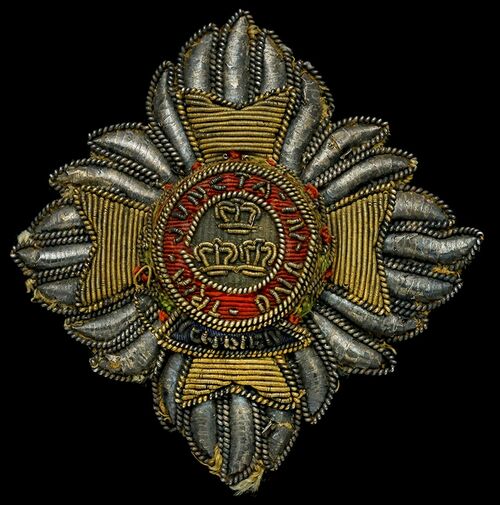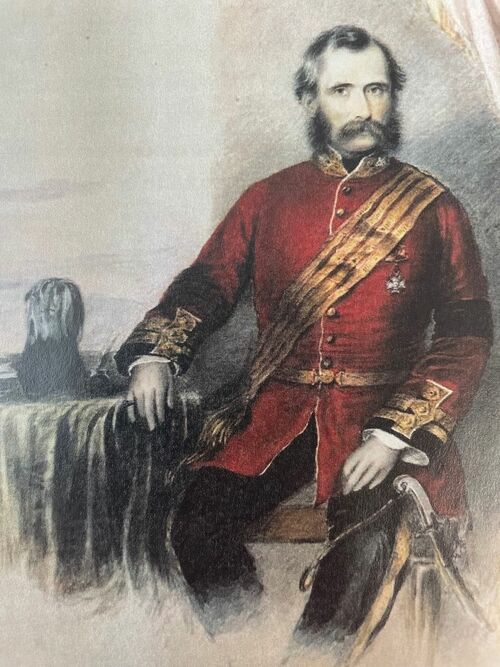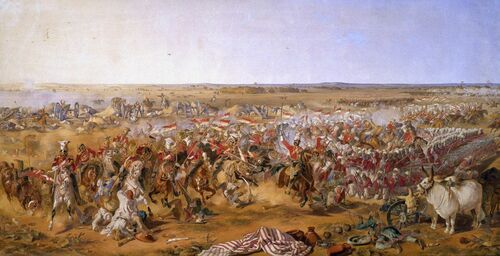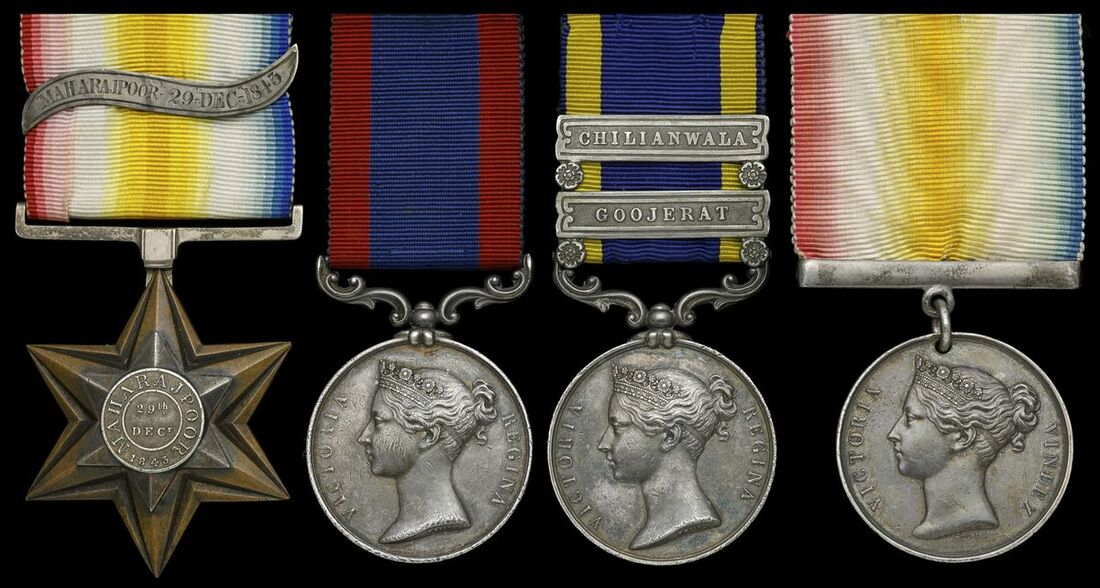Auction: 23002 - Orders, Decorations and Medals
Lot: 90
The group of five awarded to General J. F. Bradford, K.C.B., 1st Bengal Cavalry, who shared in several daring cavalry actions including Maharajpoor, the epic charge at Aliwal when his Regiment joined the 16th Lancers and lastly at Chilianwala; he would latterly be in Command of the Meerut Division in the period of 'The White Mutiny'
Cabul 1842, pierced and fitted with ring and straight-bar suspension (Captain Bradford 1st Light Cavalry); Maharajpoor Star 1843 (Captain J. F. Bradford 1st Regt. Light Cavalry), fitted with silver screw-back and straight-bar suspension and ornate slide clasp, this engraved 'Maharajpoore 29th-Decr.-1843'; Sutlej 1845-46, for Aliwal, no clasp (Lieut. Coll. Bradford 1st Light Cavalry); Punjab 1848-49, 2 clasps, Goojerat, Chilianwala (Bt. Lieut. Col. J.F. Bradford, 1st Bengal Cavy.); The Most Honourable Order of the Bath, bullion 'breast Star' representative of his appointment as Knight Commander, circa 1871, 68mm, contact marks, very fine (5)
K.C.B. London Gazette 20 May 1871.
John Fowler Bradford was born in London on 28 February 1805, the son of Captain Edward Chapman Bradford, who served in the Honourable East India Company and was an Elder of Trinity House. Educated at Hertford Castle, he was nominated as a cadet for the Bengal Infantry, on the petition of Campbell Marjoribanks in Season 1820. The petition was supported by his father with his candidacy being approved by the Military Committee at East India House, London, in 1821.
On 5 May 1821, Bradford was posted as a Cornet to the 1st Light Cavalry, landing in India that September, following which he served as Instructor and Quarter Master until March 1832.
After a furlough from 26 January 1837-10 May 1840, Bradford returned to India, where he fought in several engagements in the First Afghan War leading to the re-occupation of Kabul. A Squadron of the 1st Bengal Light Cavalry took part in the famous charge which routed 2,000 of Akbar Khan's horsemen and captured an Afghan standard.
With the British weakened by the Retreat from Kabul, the Mahrattas of Gwalior saw an opportunity to gain independence. Bradford, by now a Captain with his Regiment formed part of General Sir Hugh Gough's force, which marched into Gwalior in two Columns. At the Battle of Maharajpoor on 29 December 1843, Gough's cavalry advanced on the right wing, turning the Mahrattan flank. Pursuing the fleeing enemy to the banks of the River Ahsin, the cavalry inflicted some 3,000 casualties. Sadly, the Commanding Officer of the Regiment, Major G. R. Crommelin, was killed in action.
At the battle of Aliwal during the First Sikh War, Bradford commanded the 1st Light Cavalry, when they supported the 16th Lancers in their epic charge. The cavalry broke directly through an enemy square and routed the Sikh army, but at a high price. Bradford's regiment lost 9 men and some 23 horses. During the pursuit across the Sutlej, 67 guns were captured. For their work that day they were granted an honourable mention in the despatches of Major-General Sir Harry Smith, the Commander-in-Chief.
Bradford saw further action at both Chilianwala and Goojerat. At Chilianwala The 1st Bengal Light Cavalry were involved in the notorious 'Threes About!' incident on 13 January 1849.
On that day Gough encountered the Sikhs at Chilianwala, and two Squadrons of the 9th Lancers were brigaded with four Squadrons of the 14th Light Dragoons, and one and a half Squadrons from each of the 1st and 6th Bengal Light Cavalry, under the elderly Brigadier Pope, on the right of the British line. Pope, who had no experience of handling large bodies of cavalry, formed his brigade in a long single line with no supports or reserves. 14th Light Dragoons were on the left, the 1st and 6th Bengal Light Cavalry in the centre and the 9th Bengal Light Cavalry on the right. Anxious for his cavalry to keep in touch with the infantry, Pope ordered the Brigade to advance at a trot into the jungle but soon found it heavy going, and the trot was soon reduced to a walk. Gradually the advance began to veer to the left masking Christie's guns.
By this time the whole line had come to a halt, and in order to rectify the situation the command "Threes Right!" (sic) was about to be issued, when a body of Sikh horse was sighted ahead. The commanding officer of the 14th urged Pope to charge, but then he was wounded. Some officers of the native cavalry, having galloped ahead of the line and having come up against the Sikh horse unsupported, came galloping back and the order "Threes About!" was shouted.
No one has ever established exactly who gave this order, but it appears to have emanated from the Light Cavalry. Whatever its origin, the Brigade conformed, turning its back on the enemy who then charged. Within a moment the whole British line was galloping towards the rear, with some men riding over Christie's guns which fell into the hands of the Sikhs.
Christie was mortally wounded and although the European element of the brigade rallied in the administrative area, the native cavalry were not seen for the rest of the day. Gough's Chaplain held up a number of the returning troopers at pistol point, and at length several officers managed to rally their men and drive off the Sikhs. Though Hope Grant appears '...to have pulled his Squadrons together pretty quickly', the only man to emerge from the disaster with any credit at all was the Chaplain, whom Gough wanted to make 'a Brevet Bishop'.
Bradford again distinguished himself in the battles of Chilianwala and Goojerat. He was mentioned '...with great approbation' by Major-General Sir Joseph Thackwell, Commander-in-Chief of the Cavalry Division. For his gallant service in the Sikh Wars, Bradford was appointed a C.B. (London Gazette 9 June 1849, refers).
His next appointment was commanding the Meerut Division in 1858, probably one of the most challenging periods in his career in what became known as 'The White Mutiny'.
The seeds were sown in a proclamation made at the Durbar in Allahabad in November 1858 when Lord Canning, Governor-General of India, read out the premature Queen's Proclamation abolishing the 250-year rule of the East India Company and transferring the government of India direct to the Crown. Among the many sweeping reorganisations envisaged, the transfer of power meant that the soldiers of the three Presidency Armies of Bengal, Madras and Bombay would now be required to make over their allegiance from the defunct 'John Company' to the Queen, as in the British Army.
A turbulent period of unrest followed caused by the resentment of the European troops of the British East India Company against their transfer, without consultation or their consent, to the service of the Queen, became known as 'The White Mutiny'.
On the evening of 1 May 1860, shortly after hearing that hopes of discharge or re-enlistment with bounty were 'inadmissible' 400 men of the Bengal Artillery and the 2nd Cavalry met surreptitiously to discuss the issue. Bradford, commanding the Division, sent a telegraphic despatch to Clyde reporting the troops being in '...very bad spirit'.
Bradford's reports became more alarming, on 5 May he reported finding 'inflammatory writings' on the wash houses of the 2/4th Foot Artillery, a traditional form of protest among soldiers. The graffiti included 'Unity is strength!' and 'John Company is dead; we will not soldier for the Queen'. Protests erupted at station after station, first and most seriously became evident at Meerut, the depot and headquarters of the Bengal Artillery.
The issues were eventually settled when the demands of free and clear release with free passage home for the men and officers of the European Forces was accepted. Unsurprisingly, he several times mentioned in White Mutiny: British Military Culture in India by Peter Stanley.
Made K.C.B. in 1871, he married Eliza Ouseley in 1875 and retired on 31 December 1877 with the rank of General. He died at home at 40 Norfolk Square, London, on 11 April 1889.
The British Library hold his notes and diaries on Indian life (Ms Eur D.1057 1842-49, 1854-56), while the National Army Museum hold a watercolour portrait of him wearing his C.B. (NAM1978-04-42). The cloth bullion Star is always known to have been present with his Medals, as evidenced by its featuring on the image on the family history website (https://www.manfamily.org/about/other-families/bradford-family/).
For the Medal of his son, please see Lot 19.
Subject to 20% VAT on Buyer’s Premium. For more information please view Terms and Conditions for Buyers.
Sold for
£5,500
Starting price
£2400











